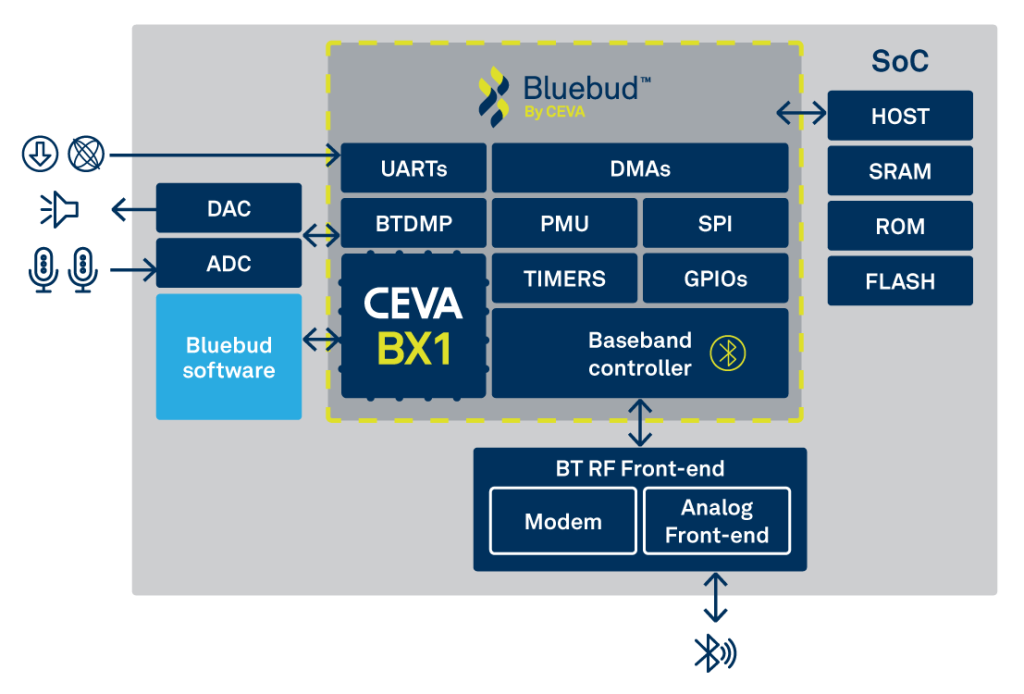– Originally written by Franz Dugand, director of Sales & Marketing, Wireless IoT BU, CEVA –
Smart phones are unquestionably powerful and all-capable but, in some ways, they’ve become the new ‘luggable’. Rather bulky, somewhat heavy and not as convenient as we’d like them to be.
Whether you’re jogging, at the gym, or hiking, messing with a phone can be awkward. Part of the appeal of a smart watch is simply its convenience: it’s lightweight and wearable. The screen is a little constrained, but for many applications that’s easily resolved with some clever UX (user experience) design wizardry.
With your smart watch, not only can you receive and make phone calls, but also listen to and control playlists.
The opportunity
Smart watches and fitness trackers are also an active growth segment, not as dominated by 800-pound gorillas as the smart phone market. The smart watch market was already at $20bn in 2019, with a projected CAGR of nearly 20%. The fitness tracker market is as good or better, at $36bn in 2020, with a projected CAGR of 15% to 2028.
Smart watch shipments are dominated by Bluetooth dual-mode (classic and Bluetooth Low Energy, or BLE) offering full audio capability. Whereas, fitness trackers are projected to be almost exclusively BLE-based with lower-end audio support. In either case these are multiple tens of millions of units shipping each year, growing to as many as 100 million units by 2025.
That’s a lot of opportunity, which probably explains why we’re having so many discussions now with smart watch makers, all of whom are looking for low-power packaged Bluetooth plus an audio solution for their products.
Building on proven turnkey solutions
Building any kind of smart product today is demanding. It requires technology and expertise in multiple complex domains, more than most consumer product developers can afford to master in any reasonable timeframe.
That makes drop-in intellectual property (or IP) from established experts appealing. One example is the Bluetooth (BT) radio. BT is a rapidly evolving standard, supporting a widely used low-energy option (BLE).
It also now supports longer reach and mesh connectivity. Yet, any consumer device must maintain backward compatibility through earlier versions. Your phone, earbuds, and headsets are not all guaranteed to be at the latest generation and they must be certified. None of this should be attempted if you’re not a Bluetooth expert.
Another challenging technology is audio. To be competitive, products must deliver high quality audio, especially for those of premium nature. To support a great UX in a constrained form-factor, many will offer voice recognition.
Watches may commonly mediate audio between the phone and earbuds, or headset. If you’re not wearing earbuds or a headset, they can act as a direct audio interface, for phone calls or as a simple speaker. Audio support requires more technology than a simple channel can provide. This can be for audio quality and command recognition.
Bluebud – a turnkey embedded solution

The baseband controller, RF front-end, peripherals, codecs, and all the necessary hooks, allow you to add your own differentiation. All you need do is connect through the standard OpenAMP interface, with a speaker and microphone on one side. On the other side, connect an application host MCU.
Bluebud platform will enable this, which incidentally can also manage your smart home devices. This will include lighting, as well as health and fitness sensing. You can also connect IMU, temperature and heartbeat sensing into Bluebud, in addition to the features already discussed.
Published on Hardware Pioneers.

